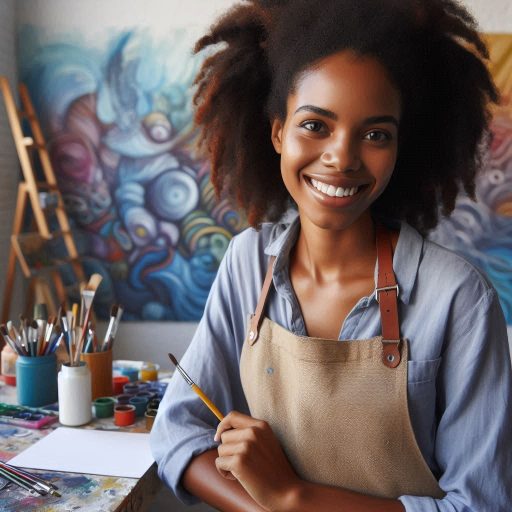Introduction
Murals are large-scale paintings on walls or buildings.
They serve as powerful forms of public art, conveying messages and emotions.
Historically, murals have recorded events, cultures, and social movements.
They can transform bland spaces into vibrant expressions of creativity.
Urban development involves the design and improvement of urban areas.
This process shapes cities and influences residents’ quality of life.
Key aspects of urban development include:
- Infrastructure: Enhancing roads, transportation, and public facilities.
- Housing: Providing affordable and sustainable living options.
- Public Spaces: Creating parks and recreational areas for communities.
- Economic Growth: Stimulating local businesses and attracting investments.
Murals play a vital role in urban development.
They can beautify neighborhoods, foster community pride, and attract tourism.
Additionally, murals often reflect local culture and history, creating a sense of identity.
As cities continue to grow, integrating murals into urban planning becomes essential.
They not only enhance aesthetics but also promote social interaction and community engagement.
The Role of Murals in Urban Development
How murals contribute to the revitalization of urban spaces
Murals significantly contribute to the revitalization of urban spaces.
They transform dull and neglected areas into vibrant cultural hubs.
Communities often commission murals to reflect local history and identity.
This fosters pride among residents, enhancing community cohesion.
Murals can attract tourists, boosting local economies.
People travel to see renowned street art, bringing business to nearby shops and restaurants.
This influx of visitors encourages further investment in the area.
As more murals appear, neighborhoods become more appealing to potential residents and businesses.
Transform Your Career Today
Unlock a personalized career strategy that drives real results. Get tailored advice and a roadmap designed just for you.
Start NowExamples of cities where murals have played a significant role in urban development
Several cities showcase the impact of murals on urban development.
In Philadelphia, the Mural Arts Program has transformed neighborhoods through public art.
Over 4,000 murals have created a unique cultural landscape, attracting millions of visitors.
This initiative has revitalized communities and reduced crime rates in previously neglected areas.
In Berlin, murals reflect the city’s rich history and dynamic culture.
The East Side Gallery, a section of the Berlin Wall, features colorful murals by international artists.
This open-air gallery draws tourists and locals alike, fostering a sense of unity and remembrance.
The city’s vibrant street art scene encourages ongoing urban renewal.
In Buenos Aires, the neighborhood of La Boca is famous for its colorful murals.
These artworks tell stories of the city’s immigrants, enriching its cultural identity.
Murals not only beautify the area but also support local artists and businesses.
In fact, murals play a vital role in urban development.
They revitalize spaces, boost local economies, and enhance community identity.
As cities continue to embrace murals, they unlock the potential for cultural enrichment and sustainable growth.
Read: Glass Art: Safety Tips for New Artists
Social Impact of Murals in Urban Areas
How murals can reflect the cultural diversity and identity of a community
Murals play a significant role in shaping the social landscape of urban areas.
They serve as vibrant reflections of a community’s cultural diversity and identity.
Each mural tells a story, celebrating local traditions, histories, and values.
By incorporating symbols and motifs unique to the community, murals foster a sense of belonging.
Residents feel represented, creating a deeper connection to their surroundings.
Transform Your Career Today
Unlock a personalized career strategy that drives real results. Get tailored advice and a roadmap designed just for you.
Start NowMoreover, murals can enhance the visual appeal of neighborhoods.
They transform blank walls into canvases of expression, attracting visitors and residents alike.
This beautification can encourage pride in the community and inspire further artistic endeavors.
As a result, neighborhoods often experience revitalization, drawing new businesses and tourism.
How murals can promote inclusivity and social cohesion in urban neighborhoods
Murals also play a crucial role in promoting inclusivity.
They provide a platform for underrepresented voices, allowing artists to share their experiences and perspectives.
By showcasing diverse narratives, murals challenge stereotypes and encourage dialogue among residents.
This dialogue fosters understanding and respect for different cultures within the community.
Social cohesion is another essential aspect of murals in urban settings.
They can unite individuals from various backgrounds, sparking conversations and collaborative projects.
Community members often come together to create or maintain murals, building connections through shared experiences.
This teamwork cultivates a sense of ownership and responsibility for the space.
In short, murals significantly impact urban areas by reflecting cultural diversity and promoting social cohesion.
They enrich the community’s identity and encourage inclusivity, fostering connections among residents.
As cities continue to evolve, the role of murals in enhancing social dynamics will remain vital, transforming urban landscapes into vibrant expressions of community spirit.
Read: Balancing Creativity and Client Expectations in Murals

Economic Benefits of Murals in Urban Areas
Murals transform urban spaces into vibrant destinations.
Their visual appeal attracts tourists and boosts local businesses significantly.
Cities that embrace murals often experience increased foot traffic, leading to higher sales for nearby shops and restaurants.
How Murals Can Attract Tourists and Boost Local Businesses
Murals serve as powerful attractions for tourists seeking unique experiences.
Transform Your Career Today
Unlock a personalized career strategy that drives real results. Get tailored advice and a roadmap designed just for you.
Start NowThey often become social media hotspots, encouraging visitors to share images online.
This exposure enhances a city’s reputation as a cultural hub, drawing more visitors.
Local businesses can capitalize on this increased foot traffic by offering special promotions or themed events.
Cafés and shops near popular murals frequently report increased sales, especially during peak tourist seasons.
Case Studies of Cities Where Murals Have Led to Increased Property Values and Economic Growth
Several cities illustrate the economic impact of murals.
In Philadelphia, vibrant murals have revitalized neighborhoods, leading to a surge in property values.
The Mural Arts Program has transformed dull walls into stunning artworks, making areas more desirable for residents and investors.
Similarly, in Wynwood, Miami, murals turned a neglected warehouse district into an art mecca.
This transformation attracted galleries, boutiques, and restaurants.
The economic boom in Wynwood is evident, with property values skyrocketing and new businesses opening regularly.
In Los Angeles, murals in the Arts District have sparked significant economic growth.
The area has become a creative hub, attracting both locals and tourists.
As a result, property values in this once-underappreciated neighborhood have soared.
In essence, murals are more than just art; they drive economic benefits in urban areas.
By attracting tourists and enhancing property values, murals foster thriving local economies.
Cities that invest in public art reap rewards that extend beyond aesthetics, creating vibrant, economically robust communities.
Read: Inspirational Glass Art Design Ideas
Environmental Impact of Murals in Urban Settings
Murals significantly enhance urban environments.
They beautify neighborhoods, transforming dull walls into vibrant canvases.
This transformation fosters community pride and identity.
Transform Your Career Today
Unlock a personalized career strategy that drives real results. Get tailored advice and a roadmap designed just for you.
Start NowAs residents engage with these artworks, they often develop a stronger connection to their surroundings.
How murals can contribute to the beautification of neighborhoods and decrease crime rates
Studies show that beautified neighborhoods can see a decrease in crime rates.
Murals create a sense of ownership and responsibility among locals.
When people take pride in their environment, they are less likely to engage in vandalism or neglect.
A colorful mural can serve as a deterrent, attracting positive attention and discouraging criminal behavior.
How murals can inspire environmental awareness and sustainable practices
Additionally, murals can inspire environmental awareness.
Artists often use their work to highlight ecological issues.
They may depict themes of sustainability, climate change, and biodiversity.
This artistic expression prompts viewers to reflect on their relationship with the environment.
Murals can also promote sustainable practices within communities.
By showcasing local flora and fauna, artists educate residents about native species.
This knowledge can encourage people to create green spaces and gardens.
As neighborhoods become more eco-conscious, they may adopt practices like recycling and composting.
Furthermore, murals can serve as platforms for community events focused on environmental education.
Workshops and activities organized around these artworks can engage residents of all ages.
This involvement fosters a culture of sustainability, encouraging collective action for environmental preservation.
In a nutshell, murals play a vital role in urban development.
They beautify neighborhoods, reduce crime, and inspire environmental awareness.
By engaging communities, murals can lead to a more sustainable future.
As cities continue to grow, the importance of integrating art into urban planning becomes increasingly clear.
Transform Your Career Today
Unlock a personalized career strategy that drives real results. Get tailored advice and a roadmap designed just for you.
Start NowRead: Collaborating with Communities on Mural Projects
Challenges and Controversies Surrounding Murals in Urban Development
The issue of gentrification and displacement of communities due to mural projects
Gentrification is a complex issue that often accompanies urban development projects, including murals.
One of the main concerns is that as neighborhoods undergo revitalization through the addition of murals, property values tend to rise.
This increase in property values can lead to the displacement of long-time residents who can no longer afford to live in the area.
It is essential for city planners and mural artists to be mindful of the potential impact their projects may have on the social fabric of the community.
Community input and engagement are key in addressing these challenges.
The importance of community involvement and consultation in mural projects
Community involvement in mural projects is crucial for ensuring that the artwork reflects the values and identity of the neighborhood.
Consulting with local residents and community organizations can help to create murals that are meaningful and relevant to the people who live there.
Incorporating local history, culture, and stories into the artwork can foster a sense of pride and ownership among residents.
Engaging the community in the planning and execution of mural projects can also help to build relationships and strengthen social connections.
Ultimately, community involvement can lead to more successful and sustainable mural projects that have a positive impact on urban development.
Future Trends in the Integration of Murals in Urban Development
New Technologies and Techniques in Mural Making
As urban spaces evolve, mural-making technologies are advancing rapidly.
Artists now use digital tools to design and visualize murals before execution.
Augmented reality (AR) enhances viewer experiences, allowing interactive elements within murals.
Additionally, eco-friendly paints are becoming standard, promoting sustainability.
Techniques such as projection mapping bring murals to life, creating dynamic displays that change over time.
These innovations will make murals more engaging and relevant in urban environments.
Collaboration Between Artists, Architects, and Urban Planners
Collaboration among artists, architects, and urban planners is essential for successful mural projects.
Artists can provide unique insights into community identity and culture.
Architects can integrate murals into building designs, enhancing aesthetics and functionality.
Transform Your Career Today
Unlock a personalized career strategy that drives real results. Get tailored advice and a roadmap designed just for you.
Start NowUrban planners can ensure murals address local needs and engage the public.
This multidisciplinary approach fosters innovative and sustainable mural projects that reflect community values.
Combining diverse perspectives leads to murals that serve as community focal points.
This collaboration can also promote local artists and stimulate economic growth.
Joint efforts can transform neglected spaces into vibrant, inclusive areas, benefiting all residents.
The future of murals in urban development lies in innovation and collaboration.
Embracing new technologies will enhance mural creation and viewer engagement.
Meanwhile, partnerships between artists, architects, and planners will ensure projects are sustainable and meaningful.
As cities continue to grow, murals will play a vital role in shaping urban landscapes, fostering community connections, and celebrating cultural diversity.
By prioritizing creativity and collaboration, we can envision urban spaces that inspire and uplift.
Conclusion
Murals significantly influence urban development in various ways.
They enhance community identity, foster local pride, and attract tourism.
Throughout this blog post, we explored key points regarding murals’ impact.
Key benefits of murals include:
- Cultural expression: Murals reflect local history and traditions.
- Economic boost: They attract visitors and increase foot traffic for businesses.
- Social engagement: Murals encourage community participation and dialogue.
Murals also contribute to beautifying urban spaces.
They transform dull walls into vibrant artworks, making neighborhoods more inviting.
The lasting impact of murals on urban development cannot be overstated.
To ensure these benefits continue, we must prioritize the preservation of public art.
Supporting mural projects fosters creativity and community connection.
Engaging with local artists and promoting their work creates a thriving artistic environment.
Transform Your Career Today
Unlock a personalized career strategy that drives real results. Get tailored advice and a roadmap designed just for you.
Start NowIn closing, murals play a crucial role in shaping urban landscapes.
Their power to inspire and uplift communities is invaluable.
Let us celebrate and promote public art, ensuring that it remains a vibrant part of our cities.




